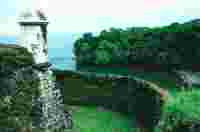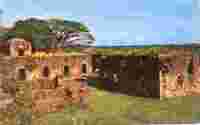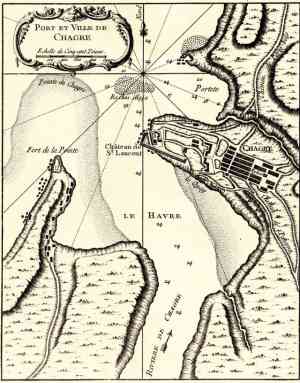
(1595 - 1770)
|
||
|
||
|
||
|
With the movement of the government from Santa Maria de Antigua del Darien to Panama, the need for a route of communication between Panama, on the South Sea and the Caribbean coastal towns was needed. The mouth of the Chagres River was an excellent choice since it was directly across from Panama, on the narrowest strip of the isthmus, with a distance of less than 50 miles. A road was eventually constructed from Panama to the town of Venta de Cruces, half way across the isthmus, on the banks of the Chagres River. From there, you could take river boats, to sail down the river, to the town of Chagres. From the town of Chagres, the treasures were transported by ship, to the town of Nombre de Diós and Porto Bello. Here the Treasure Fleet would pick it up, and take it to Spain. The trip across the isthmus was long and arduous, especially the trip up river, which could take up to a month, depending on the time of the year. With Francisco Pizarro's discovery of the Inca empire, and the subsequent discovery of silver at Potosi, the importance of the Chagres River, became evident, in the need to transport the new found wealth to Spain. The mouth of the Chagres River, was one of the places that the Council of the Indies, in 1564, decided to fortify. In 1595, King Phillip II, ordered that the fortress of San Lorenzo, be constructed. The site chosen was on top of the steep cliff, on the east side of the river. This offered an excellent site for a fortress since it would overlook the mouth of the river and miles out to sea. Since it was up high, it would be hard to attack from the sea, and easy for the fort to fire on ships below. The first fort, that was constructed, made use of wooden palisades, which did not stand up to the constant rains, and soon deteriorated. The constant attacks by pirates, helped weaken the defenses. In 1596, Francis Drake was able to conquer the fort, and sacked and burned the town and the fort. In 1668 and 1671, Henry Morgan attacked San Lorenzo, capturing it, and later destroying Panama. Morgan, also set fire to the fort, and spiked the cannons he did not take with him. In 1680, after Morgan had destroyed the fort, a new masonry fort was rebuilt, on the highest part of the cliff. This new fort was destroyed by the British Admiral Vernon in 1740. In 1761 the fort was rebuilt for the third time. This time the fort was improved, strengthening the walls and fortifications. Soon after the new Castillo de San Lorenzo was finished, the need for it disappeared, and gold and silver, was never again transported to it. The new fort was never attacked again, and this is the fort that we see in the photos above. In 1821, after Nueva Granada, and South and Central America, gained their independence from Spain, the Castillo de San Lorenzo, was abandoned by Spain. It became a prison, after Panama became part of Colombia, and as the point of entry for mail coming from England to Latin America. In 1849, during the Californian Gold Rush, it found renewed importance, as a way to get from the East Coast of the United States and California. Many of the 49er's would sail from the east coast to the town of Chagres. There they would travel up the river to the town of Cruces, and then walk, or ride mules to the city of Panama, where they could catch a ship to California. When the Panama Railroad was being build, the 49er's changed their destination from Chagres to Aspinwall. Initially they would ride the train, as far as it would go, and then continue by foot. When the railroad was completed, they would ride the train to Panama City. |
||
1764 Map of Entrance to Chagres River and Fort San Lorenzo and the town of Chagres on the other side of Chagres' estuary. |
| Panama History | Home |
Bruce C. Ruiz
October 17, 2001





